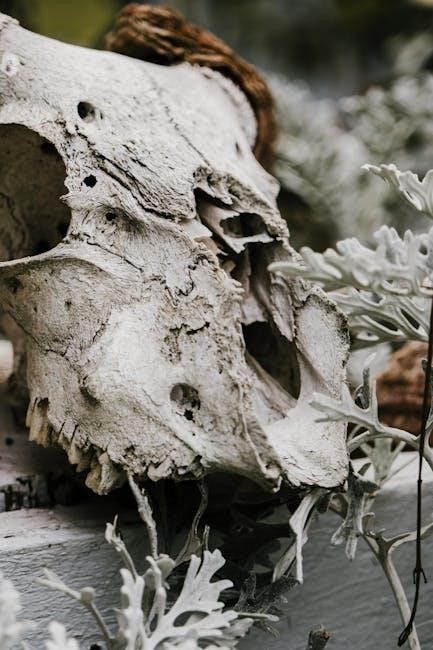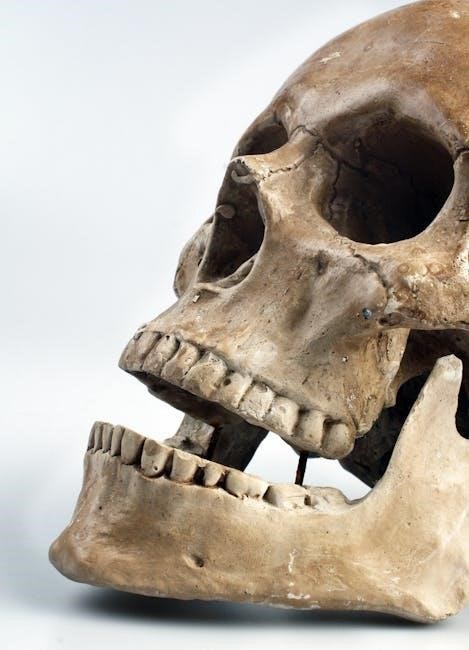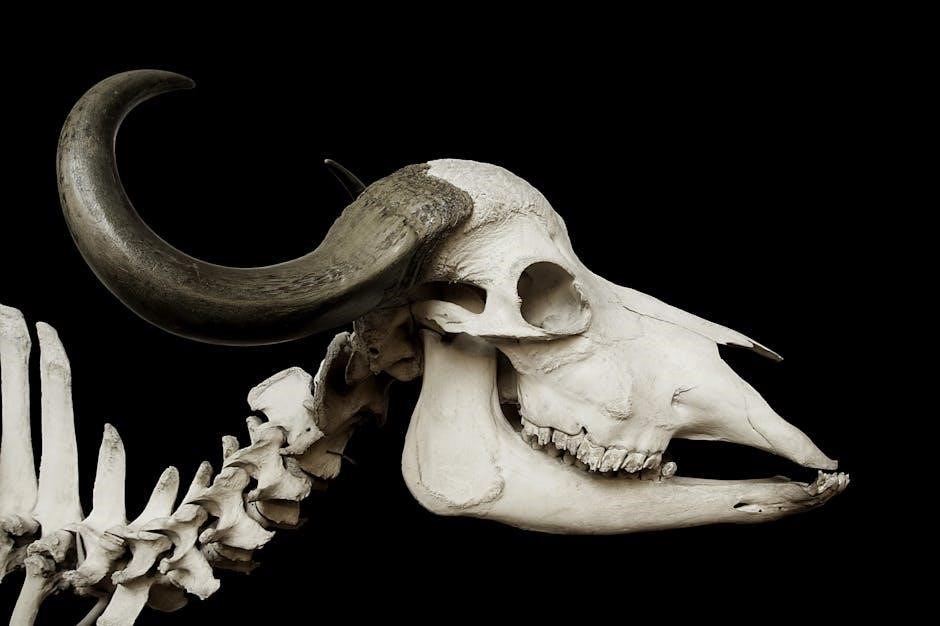The PDF version of Written in Bone by Sue Black offers a fascinating exploration of forensic anthropology, revealing life stories hidden in human remains through detailed skeletal analysis․
Overview of the Book and Its Significance
Written in Bone: Hidden Stories in What We Leave Behind by Sue Black is a captivating exploration of forensic anthropology, delving into how human remains reveal life histories․ This book, available in PDF format, builds on Black’s earlier work, offering a deeper understanding of skeletal analysis and its role in uncovering past secrets․ It signifies the importance of bones as biological archives, detailing how they reflect an individual’s life experiences, health, and identity․ The PDF version enhances accessibility, allowing readers to engage with the book’s insights on mortality, culture, and science․ This work bridges academic and public interest, making it a vital resource in the field of forensic anthropology․
The Author: Professor Dame Sue Black
Professor Dame Sue Black is a world-renowned forensic anthropologist and anatomist, recognized for her groundbreaking work in skeletal analysis and human identification․ As Pro-Vice Chancellor for Engagement at Lancaster University, she has significantly contributed to the field of forensic science․ Her expertise spans decades, earning her a Dame Commander title for her services to forensic anthropology․ Black’s work bridges academia and real-world applications, making her a pivotal figure in understanding human remains․ Her accessible writing style in Written in Bone reflects her passion for sharing complex scientific concepts with a broader audience, further cementing her legacy as a leading voice in her field․
Key Themes Explored in the Book
Written in Bone delves into the intricate stories hidden within human remains, exploring themes of identity, life history, and mortality․ Sue Black masterfully weaves forensic anthropology with personal narratives, revealing how bones act as silent witnesses to past lives․ The book examines the emotional and historical significance of skeletal remains, uncovering secrets about an individual’s ancestry, health, and experiences․ It also touches on cultural perspectives on death and the ethical considerations surrounding the study of human remains․ By blending science with storytelling, Black creates a compelling narrative that highlights the profound insights bones can offer about human existence and our shared history․

The Science of Forensic Anthropology
Forensic anthropology applies scientific methods to analyze human remains, reconstructing identities and life histories through skeletal analysis, aiding justice and understanding mortality․
Understanding the Role of Bones in Forensic Investigations
Bones are a cornerstone in forensic investigations, providing critical clues about identity, age, gender, and ancestry․ Through skeletal analysis, experts like Sue Black reconstruct life histories, identifying trauma, diseases, and lifestyle impacts․ The structure and condition of bones reveal details about an individual’s past, aiding in solving crimes and identifying remains․ Advanced techniques, such as osteology and radiology, enable precise analysis, making bones indispensable in legal and historical inquiries․ This scientific approach, as detailed in Written in Bone, highlights the profound significance of skeletal remains in uncovering truths and bringing closure to families and societies․
The Human Skeleton: A Guide to Its Structure and Significance
The human skeleton is a natural autobiography, with each bone serving as a chapter in the story of a life․ From the skull to the toe bones, every part holds clues about age, health, and identity․ The structure of bones like the spine, arms, and legs reveals how a person lived, worked, and even died․ In Written in Bone, Sue Black explains how the skeleton is a roadmap to life history, with fractures, scars, and wear offering insights into an individual’s experiences․ This skeletal guide is not just a scientific tool but also a deeply personal and emotional link to the past․
How Bones Reveal Life Histories
In Written in Bone, Sue Black explores how bones act as silent witnesses to lives lived․ Each skeleton holds a unique story, with fractures, scars, and wear revealing details about diet, health, and occupation․ For instance, repetitive strain in arm bones might indicate a laborer, while a skull fracture could suggest a violent end․ The spine and joints expose lifelong physical burdens, while teeth reveal dietary habits and age․ Even the smallest bones, like those in the feet, can tell tales of movement and activity․ This osteobiographical approach allows forensic anthropologists to reconstruct lives with remarkable accuracy, transforming bones into vivid narratives of the past․

Sue Black’s Expertise and Contributions
Professor Dame Sue Black is a world-leading forensic anthropologist, renowned for her groundbreaking work in skeletal analysis and her ability to uncover life stories from bones․
Background and Achievements of Professor Dame Sue Black
Professor Dame Sue Black is a world-renowned forensic anthropologist and anatomist, recognized for her exceptional contributions to the field․ As Pro-Vice Chancellor for Engagement at Lancaster University, she has led groundbreaking research in skeletal analysis․ Her work has significantly advanced the understanding of human remains, aiding in criminal investigations and historical studies․ Black’s expertise in identifying trauma, disease, and life experiences from bones has made her a pivotal figure in forensic science․ She is also the author of All That Remains, a critically acclaimed book on death and the human body․ Her achievements have earned her numerous honors, including a damehood for her services to science․
Her Work in Forensic Anthropology and Anatomical Research
Professor Dame Sue Black’s work in forensic anthropology has revolutionized the field through meticulous skeletal analysis․ Her research focuses on identifying life histories, trauma, and diseases from human remains, providing critical insights for criminal investigations and historical studies․ Black’s expertise in anatomy and forensic science has been instrumental in developing methodologies for understanding mortality and human identity․ Her work bridges the gap between science and storytelling, making complex anatomical details accessible to a broader audience․ Through her research and public engagement, she continues to advance the field, ensuring forensic anthropology plays a vital role in uncovering the past and solving contemporary cases․
Previous Works and Their Impact on the Field
Professor Dame Sue Black’s previous works, such as All That Remains, have significantly influenced forensic anthropology․ Her storytelling approach to science has made complex concepts accessible, earning her widespread acclaim․ All That Remains became a Sunday Times bestseller, solidifying her reputation as a leading voice in the field․ Her ability to weave personal experiences with scientific insights has inspired both professionals and the general public․ Black’s earlier publications laid the foundation for Written in Bone, showcasing her unique perspective on mortality and the human body․ Her work continues to shape the field, emphasizing the importance of understanding life through death․

Hidden Stories in Bones
Bones reveal life experiences, from diet and trauma to lifestyle and heritage, offering profound insights into human history and mortality through forensic anthropology․
Revealing Life Experiences Through Skeletal Analysis
Through meticulous skeletal analysis, forensic anthropologists uncover life experiences, such as diet, trauma, and lifestyle, hidden within bones․ Sue Black’s work demonstrates how fractures, teeth wear, and joint disease reveal personal histories․ The human skeleton acts as a biological archive, preserving evidence of past events․ This scientific approach not only aids in legal investigations but also provides emotional and historical context to lives once lived․ The PDF version of Written in Bone offers a detailed exploration of these methods, showcasing how bones tell stories of survival, hardship, and identity, making it a compelling read for those intrigued by the intersection of science and humanity․
Case Studies: Uncovering Secrets from the Past
Sue Black’s work in Written in Bone highlights remarkable case studies where skeletal remains reveal hidden truths about individuals’ lives․ From analyzing fractures to deciphering signs of disease, each bone tells a story․ One notable case involves a young woman whose skeleton revealed a life of hardship, while another case uncovered evidence of a tragic accident․ These examples demonstrate how forensic anthropology bridges the gap between science and history․ The PDF version of the book provides vivid details of these cases, offering readers a glimpse into the emotional and historical significance of bones as silent witnesses to the past․
The Emotional and Historical Significance of Bones
Bones hold profound emotional and historical significance, serving as tangible links to past lives․ They carry stories of love, loss, and legacy, offering insights into human experiences across generations․ In Written in Bone, Sue Black shares her own emotional journey, recounting how her work has shaped her perspective on mortality․ The PDF version of the book emphasizes how bones transcend science, becoming gateways to understanding cultural practices, historical events, and personal histories․ By examining skeletal remains, we honor the lives of those who came before us, preserving their memories and stories for future generations․ Bones are not just remnants; they are living history․

The PDF Version of “Written in Bone”

The PDF version of Written in Bone is easily accessible online, offering a comprehensive and portable format for readers to explore Sue Black’s fascinating insights anywhere, anytime․
Availability and Accessibility of the PDF Format
The PDF version of Sue Black’s Written in Bone is widely available online, ensuring easy accessibility for readers globally․ Platforms like Issuu and various ebook repositories offer free downloads, making it convenient for audiences to access the book without geographical or financial barriers․ The digital format is compatible with multiple devices, allowing readers to engage with the content on smartphones, tablets, or computers․ This accessibility has contributed to the book’s popularity, enabling a broader audience to explore the fascinating world of forensic anthropology and the hidden stories within human bones․ The PDF format ensures clarity and readability, preserving the detailed skeletal analysis and life histories presented in the book․
Downloading and Reading the Book in PDF
Downloading Written in Bone in PDF format is straightforward, with options available on platforms like Issuu and other digital repositories․ Readers can easily access the file using direct links, ensuring quick and hassle-free downloading․ Once downloaded, the PDF can be read on various devices, including smartphones, tablets, and computers, offering flexibility and convenience․ The digital format retains the book’s original structure, including detailed skeletal analysis and case studies, making it an excellent choice for both casual readers and professionals; Additionally, features like keyword search and zoom enhance readability, allowing readers to delve deeper into Sue Black’s insights on forensic anthropology and human history․
Benefits of the Digital Format for Readers
The PDF format of Written in Bone offers numerous benefits, including portability and accessibility․ Readers can carry the book on multiple devices, ensuring access anytime, anywhere․ The digital version allows for easy navigation with features like bookmarks and search functions, enabling quick reference to specific sections․ High-quality images and diagrams remain crisp, enhancing the understanding of skeletal analysis․ Additionally, the PDF is environmentally friendly, reducing the need for physical copies․ The convenience and flexibility of the digital format make it an ideal choice for both academic and casual readers interested in Sue Black’s work on forensic anthropology and the stories bones reveal․

Book Reviews and Reception
Written in Bone has garnered widespread acclaim for its gripping insights into forensic anthropology, earning the CWA Gold Dagger for Non-Fiction and leaving a lasting impact on readers․
Critical Acclaim and Reader Feedback
Written in Bone has been praised for its gripping narrative and scientific depth, earning it the CWA Gold Dagger for Non-Fiction․ Readers and critics alike have lauded Sue Black’s ability to weave forensic anthropology with storytelling, making complex concepts accessible․ The book’s unique blend of personal anecdotes and skeletal analysis has resonated deeply, with many calling it a masterpiece in its field․ The PDF version has further expanded its reach, allowing global readers to explore the hidden stories within human remains․ Dr․ Richard Shepherd, author of Unnatural Causes, described it as “gripping from the start,” highlighting its universal appeal to both experts and casual readers․
Comparisons with Sue Black’s Previous Work
Written in Bone builds on Sue Black’s earlier work, All That Remains, offering a deeper dive into forensic anthropology․ While her previous book focused on death’s emotional and cultural aspects, this one delves into the science of skeletal analysis, revealing life stories hidden in bones․ The narrative style remains engaging, but the scientific depth has expanded, showcasing her expertise․ Readers have praised the seamless blend of personal anecdotes and technical insights, making it a standout in her bibliography․ This book solidifies her reputation as a leading voice in the field, providing a fresh perspective that complements her earlier contributions․
Awards and Recognition for “Written in Bone”
Written in Bone has garnered significant acclaim, winning the prestigious CWA Gold Dagger for Non-Fiction, a testament to its gripping narrative and scientific rigor․ The book has also been a Sunday Times Bestseller, reflecting its broad appeal․ Reviewers, including Dr․ Richard Shepherd, have praised its masterful storytelling and depth, solidifying its place as a landmark work in forensic anthropology․ Sue Black’s expertise and unique voice have earned this book widespread recognition, making it a standout in both academic and popular circles․ Its success underscores the fascination with the stories bones tell and Black’s ability to make complex science accessible․

Forensic Anthropology in Practice
Written in Bone explores the methodologies and techniques used in forensic anthropology, aiding criminal investigations and uncovering life stories hidden in human remains with precision and care․
Methodologies and Techniques in Bone Analysis
In Written in Bone, Sue Black details the meticulous methodologies used in forensic anthropology, such as skeletal examination, osteology, and anatomical analysis․ These techniques enable experts to determine age, sex, ancestry, and stature from remains․ Advanced methods like trauma assessment and pathological condition analysis reveal life experiences and causes of death․ By studying bone structure and markers, professionals reconstruct life histories, aiding criminal investigations and historical research․ The book highlights how these scientific approaches uncover hidden stories, making bones a vital source of information about past lives and events, bridging the gap between science and storytelling․
Challenges and Ethical Considerations in the Field
Forensic anthropology, as explored in Written in Bone, faces challenges such as limited remains, environmental degradation, and interpreting trauma accurately․ Ethical dilemmas arise in handling human remains respectfully, ensuring cultural sensitivity and obtaining legal permissions․ Privacy concerns and potential emotional impacts on families are also critical․ Sue Black emphasizes the importance of maintaining scientific integrity while addressing these issues, ensuring that the work honors the deceased and supports justice systems․ Balancing technical precision with ethical responsibility remains central to the field’s practice and societal acceptance․
Real-World Applications of Forensic Anthropology
Forensic anthropology, as detailed in Written in Bone, has vast real-world applications in criminal investigations, human rights cases, and historical studies․ It aids in identifying remains, reconstructing life histories, and solving crimes, as Sue Black illustrates through case studies․ The PDF version highlights how skeletal analysis helps determine age, sex, ancestry, and trauma, crucial for legal proceedings․ Additionally, it supports disaster victim identification and resolves missing person cases․ The book’s insights are invaluable for professionals and educators, showcasing forensic anthropology’s role in justice, education, and understanding human history․ Its practical applications make it a vital resource for both specialists and general readers․

Understanding Death and the Afterlife
Written in Bone explores cultural perspectives on death, revealing how bones serve as remnants of lives lived, offering insights into mortality and the afterlife through skeletal remains․
Cultural and Historical Perspectives on Death
Cultural and historical perspectives on death vary widely, influencing how societies interact with remains․ In Written in Bone, Sue Black examines how different cultures honor the dead, from ancient burial rituals to modern practices․ Bones often hold symbolic meanings, reflecting societal values and traditions․ Historical practices, such as mummification in ancient Egypt or Roman funeral rites, highlight the significance of preserving remains․ These customs not only reveal cultural identities but also provide insights into humanity’s universal fascination with mortality․ By studying skeletal remains, forensic anthropology bridges the gap between past and present, offering a deeper understanding of life, death, and the afterlife across cultures․
The Role of Bones in Understanding Mortality
Bones serve as a permanent record of life, offering profound insights into mortality․ In Written in Bone, Sue Black reveals how skeletal remains provide a window into the past, detailing an individual’s life story․ Bones expose truths about age, health, and cause of death, while also revealing broader cultural and historical contexts․ They are a tangible connection to the deceased, holding emotional and historical significance․ Through forensic analysis, bones transcend mortality, becoming a source of knowledge and understanding․ This biological legacy underscores the enduring impact of human existence, bridging the gap between life and death in ways both scientific and deeply personal․
Sue Black’s Insights on Life and Death
Sue Black’s work in Written in Bone offers profound reflections on life and death․ She emphasizes that bones are not merely biological remnants but hold stories of lives lived․ Black’s expertise in forensic anthropology illuminates how skeletal remains reveal life experiences, from physical trauma to cultural practices․ Her insights highlight the interconnectedness of life and death, showing how understanding mortality enriches our appreciation of existence; By examining bones, Black bridges the gap between the past and present, providing a deeper understanding of human history and the emotional weight of what we leave behind․
Written in Bone masterfully unravels life stories hidden in human remains, offering a poignant blend of science and emotion․ Sue Black’s work leaves a lasting impact on our understanding of mortality and the stories we leave behind․

Summarizing the Key Takeaways from “Written in Bone”
Written in Bone by Sue Black delves into the intricate stories revealed by human remains, showcasing how bones serve as a blueprint of life experiences․ Through meticulously detailed skeletal analysis, Black illustrates how each person’s history, from physical traits to life events, is etched into their anatomy․ The book underscores the profound connection between the human body and its journey, offering readers a deeper appreciation for the science of forensic anthropology․ By bridging the gap between mortality and the stories we leave behind, Black’s work provides a compelling narrative that resonates emotionally and intellectually․
The Lasting Impact of Sue Black’s Work
Sue Black’s work in Written in Bone has left an indelible mark on forensic anthropology, advancing both the field and public understanding․ Her meticulous research and storytelling have inspired new generations of scientists and captivated readers worldwide․ By bridging the gap between science and humanity, Black’s contributions have redefined how we approach skeletal analysis, emphasizing the emotional and historical significance of remains․ Her work continues to influence real-world applications, from solving crimes to uncovering historical truths, ensuring her legacy as a pioneer in her field․
Encouraging Further Exploration of Forensic Anthropology
Sue Black’s Written in Bone has sparked widespread interest in forensic anthropology, inspiring readers to delve deeper into the field․ The book’s accessible storytelling and scientific depth make it a valuable resource for both students and professionals․ By sharing real-world applications and case studies, Black highlights the importance of skeletal analysis in solving crimes and uncovering historical truths; The availability of the PDF version ensures that her work reaches a global audience, fostering a new wave of enthusiasts and scholars․ This accessibility not only educates but also motivates future generations to pursue careers in forensic anthropology, leaving a lasting legacy․
